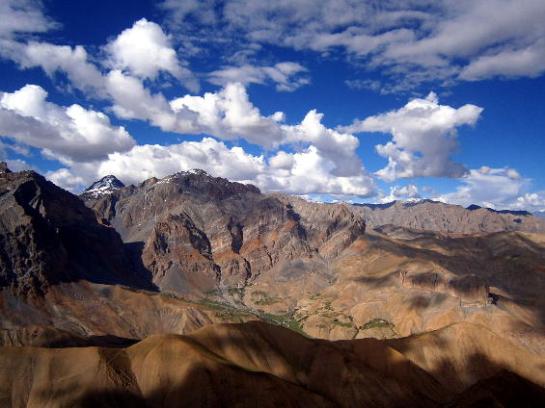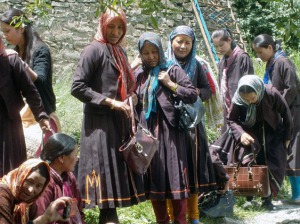Indian Himalayas, Ladakh region
Here we encounter a phenomenon which is not very popular and for most of the people is even a taboo. Have you heard of the term polyandry (dictionary def.:polygamy in which a woman has more than one husband)? Can you imagine how you share your wife with two-three more husbands, or if you are a child, you are not sure who of your three daddies is your genetic father and being a father you happily bless your daughter on her triple wedding as well as your new three sons-of-law?
Similar family order we find in the most northern mountain regions located close to the border with Tiber. For most people the polygamy, that is widely spread in the Islamic world, is not something new. We all have heard of the sultan’s harem or of rich people who have several wives, but here the situation is quite different – one woman has several husbands.
The main reason for this odd family order is the lack of land. The mountain desert region where Ladakhi people live, offers very limited space of agricultural land which is the main part of one’s property and the legacy of the parents for their children. At the traditional Ladakhi family, if there is more than one son, the land is not being divided among the offspring. All the property is inherited by the oldest brother. The other brothers are allowed to live under his roof and share literally everything: the food… and his wife.
The children of the common bride are considered children of the oldest brother and respectively he takes all the necessary care for them. Anyway there is not valid method to identify whose the child is. If a family has more than three sons the youngest are sent away to seek their own fortune and do not inherit anything. This is normal considering that here, in these remote areas where one wouldn’t even dare to take a walk, if there is a flat land and water for irrigation, it is immediately taken by someone who procreates right away.
Another interesting case is what happens in the families that have only daughters. In this case the oldest daughter inherits all and becomes the owner of the property. She can marry as many men as she wants and usually the candidates are the younger sons of other families who don’t own anything. This husband plays the role of a servant and doesn’t receive anything from his wife’s property and belongings and can be sent away at any moment. Such type of husbands are called “magpa”.
Women in Ladakh’s society enjoy full rights, has her own finances and can always start own business or divorce whenever she likes. As a result sons and daughters are equally welcomed by the families here, in opposition to other traditional societies like the Chinese for example.
Because of the hard conditions here children are considered a real treasure and nobody leaves their babies. Here even if you are а single mother you can find a husband easily. This is unthinkable for the other traditional societies where the virginity of the bride is a must as well as the genetic relation with your children. Around here even if the child is not your own you love him/her with all your heart.
The climate and the geographic location of Ladakh region (seven-eight months of winter with temperatures minus 30 degrees Celsius (minus 22 Fahrenheit), the inability to grow fruit trees and most of the vegetables, limited agricultural land and other factors) turn raising children into an uneasy task and usually families here have maximum three-four children.
By irony today in Ladakh two traditional societies collide– the Ladakhi who practice polyandry and the Kashmiri Muslims who practice polygamy. A muslim would never share his wife with another men and the Ladakhi woman would never allow other women close to her “magpa”. Because of this nowadays everywhere in the world we have the monogamist society : )
This is a joke of course, mixed marriages between Muslims and Buddhists are pretty rare here. But the ongoing modernization of the society makes polyandry less and less popular among young people, though here one can still find this kind of families in the more remote areas and among the older generation. Besides this the law in India allows only monogamist marriages.
Polyandry is a phenomenon that ensured the survival of the generations in this raw region which we could understand in profundity only if we have travelled on the Trans-Himalayan desert with remotely located small oases of life. Phenomenon that is going extinct, but still exists nowadays and amazes the travelers who come to this remote lands.
Sources: talks with local people, the book “Magic Ladakh”, author Louis Gompertz
Author: MagicKervan





There are some people who like polygyny and polyandry. So,both should be legalized. Polyandry is the best for evolution and survival of humans.
LikeLike
According to SEX AND BIRTH G.A.G.theory polyandry is the best for survival.This is a new theory which has answers to many mysteries in sex and birth(yet no one else has forwarded a logical theory.if any one disprove my theory and forward a better theory than my one I will crawl 1000 km in Sri Lanka
LikeLike